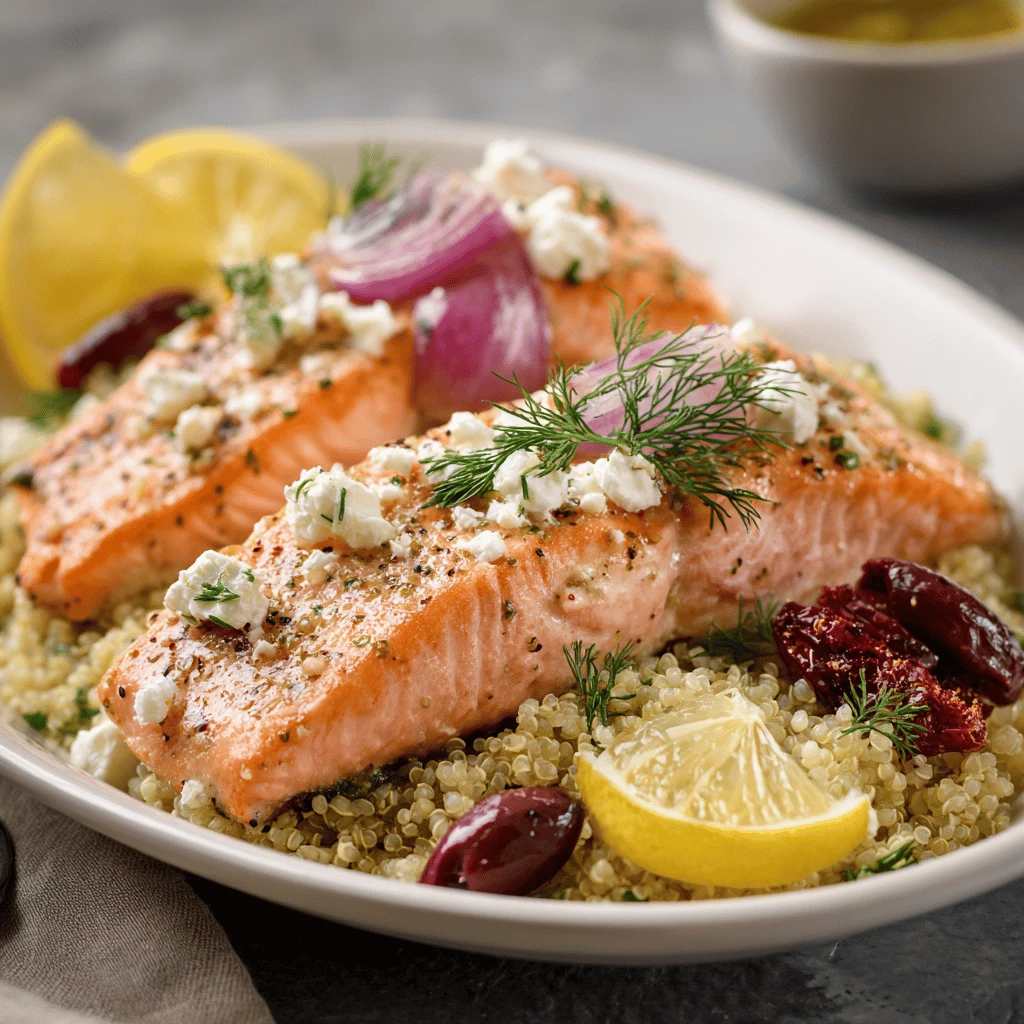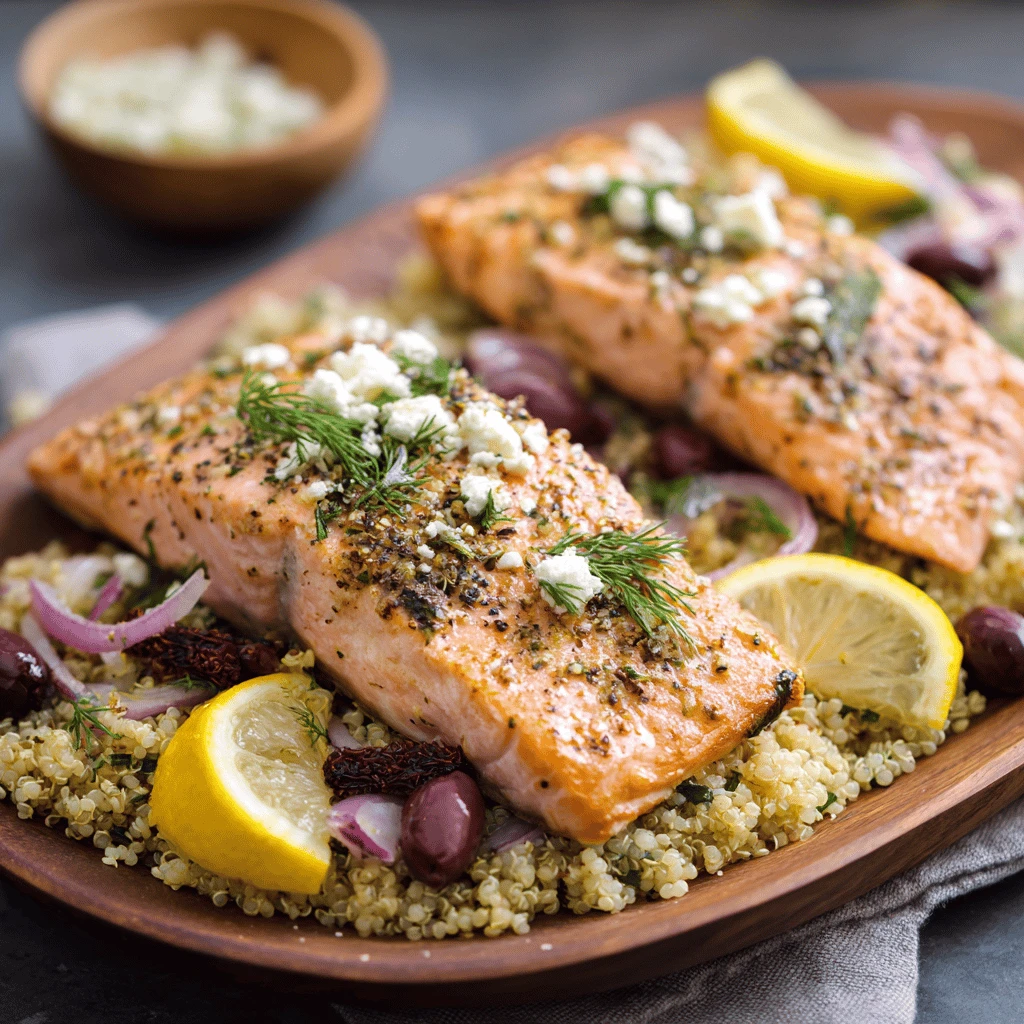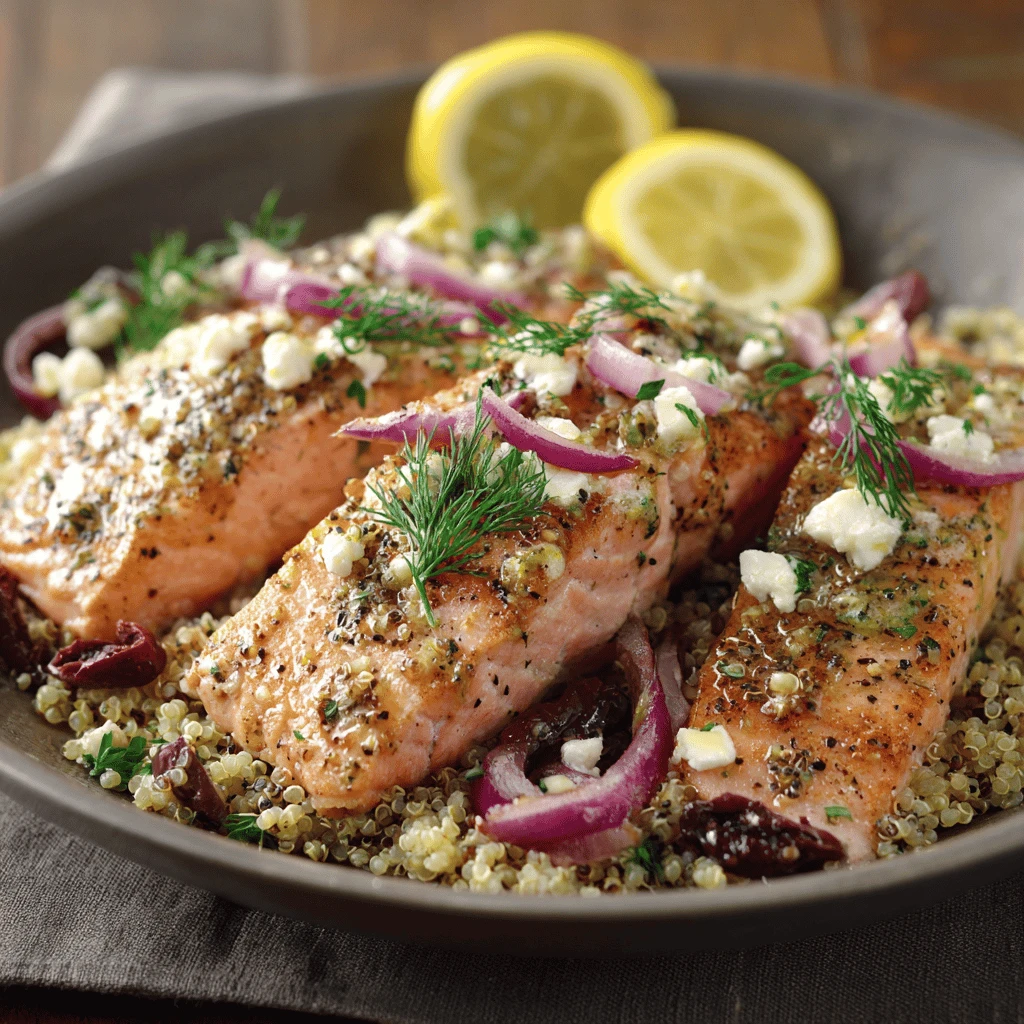Greek Lemon Dill Salmon with Quinoa
Ingredients
- 4 (6-ounce) salmon fillets, skin on or off
- 1 cup quinoa, rinsed
- 2 cups water or vegetable broth
- 1 tablespoon olive oil
- 1/2 cup red onion, finely chopped
- 2 cloves garlic, minced
- 1/2 cup fresh dill, chopped
- 1/4 cup fresh lemon juice
- 2 tablespoons olive oil
- 1 teaspoon lemon zest
- 1/2 teaspoon dried oregano
- 1/4 teaspoon red pepper flakes (optional)
- Salt and freshly ground black pepper to taste
- 1/2 cup Kalamata olives, pitted and halved
- 1/2 cup crumbled feta cheese
- 1/4 cup sun-dried tomatoes, oil-packed, drained and chopped
- Lemon wedges, for serving
Step-by-Step
1. Preheat oven to 400°F (200°C).
2. Prepare the quinoa: In a medium saucepan, combine quinoa and water or broth. Bring to a boil, then reduce heat, cover, and simmer for 15 minutes, or until liquid is absorbed and quinoa is fluffy.
3. While the quinoa is cooking, prepare the lemon-dill sauce: In a small bowl, whisk together lemon juice, olive oil, lemon zest, dried oregano, red pepper flakes (if using), salt, and pepper.
4. Sauté the aromatics: Heat 1 tablespoon of olive oil in a skillet over medium heat. Add red onion and cook until softened, about 5 minutes. Add garlic and cook for another minute until fragrant.
5. Combine quinoa and aromatics: Stir the sautéed red onion and garlic into the cooked quinoa. Add fresh dill, Kalamata olives, feta cheese, and sun-dried tomatoes. Mix well. Season with salt and pepper to taste.
6. Prepare the salmon: Pat the salmon fillets dry with paper towels. Place them on a baking sheet lined with parchment paper.
7. Brush the salmon: Brush the salmon fillets generously with the lemon-dill sauce.
8. Bake the salmon: Bake for 12-15 minutes, or until the salmon is cooked through and flakes easily with a fork. Cooking time may vary depending on the thickness of the fillets.
9. Assemble and serve: Spoon the quinoa mixture onto plates. Top with the baked salmon.
10. Garnish with extra dill and lemon wedges, if desired. Serve immediately.
Delicious Variations and Substitutions
Creating the perfect Greek Lemon Dill Salmon with Quinoa means understanding its versatility. Feel free to tailor the recipe to your specific preferences and dietary needs. Let’s explore some excellent variations and substitutions.
Salmon Alternatives
While salmon is the star, other fish can work beautifully.
Consider using sea bass or cod as substitutes. These fish offer a similar flaky texture and mild flavor that complements the lemon-dill sauce. Adjust cooking times based on the thickness of the fillets. Another option is trout, which also has a rich flavor.
Quinoa Swaps
If quinoa isn’t your favorite grain, there are plenty of alternatives.
Couscous or brown rice makes a great base. These grains absorb the flavors of the dill, olives, and feta wonderfully. For a low-carb option, cauliflower rice is an excellent substitute. Ensure to adjust cooking methods for each grain to achieve optimal texture.
Flavor Enhancements
Elevate the Greek flavors with some simple additions.
A pinch of smoked paprika added to the lemon-dill sauce adds depth. Fresh parsley or mint provide brighter, herbaceous notes. A drizzle of honey or maple syrup balances the acidity of the lemon. Experiment with different herbs and spices to find your ideal combination.
Health Benefits of Greek Lemon Dill Salmon
This dish is not only delicious but also packed with nutrients. Let’s look at the key health benefits.
Omega-3 Fatty Acids
Salmon is rich in omega-3 fatty acids, crucial for heart health.
Omega-3s help lower blood pressure and reduce the risk of heart disease. Regular consumption of salmon can improve brain function and cognitive health. These healthy fats are essential for overall well-being.
Protein Powerhouse
Salmon provides a significant amount of high-quality protein.
Protein is vital for building and repairing tissues in the body. It helps maintain muscle mass and supports a healthy metabolism. Including salmon in your diet can contribute to satiety and weight management.
Nutrient-Rich Quinoa
Quinoa is a complete protein, containing all nine essential amino acids.
It’s also a good source of fiber, which aids digestion and promotes gut health. Quinoa provides important minerals like magnesium and iron. This grain is a versatile and nutritious addition to any meal.
Tips for Perfectly Cooked Salmon
Achieving perfectly cooked salmon can seem daunting. Here are some tips to ensure success.
Don’t Overcook
Overcooked salmon is dry and lacks flavor.
Use a fork to check for doneness; it should flake easily. An instant-read thermometer inserted into the thickest part should read 145°F (63°C). Remember, the salmon will continue to cook slightly after being removed from the oven.
Skin On or Off?
Both options have their merits.
Cooking salmon with the skin on helps retain moisture. The skin also becomes crispy and flavorful. If you prefer skinless salmon, remove it before or after cooking. When baking, placing the skin-side down on parchment paper prevents sticking.
Marinating for Flavor
Marinating can enhance the flavor of salmon.
Marinate the salmon in the lemon-dill sauce for at least 30 minutes. This allows the flavors to penetrate the fish. Avoid marinating for too long, as the acid in the lemon juice can break down the fish’s texture.
Serving Suggestions and Pairings
This dish pairs well with a variety of sides and beverages. Consider these options for a complete meal.
Side Dish Ideas
Complement the salmon with fresh and vibrant sides.
A simple Greek salad with cucumbers, tomatoes, and olives is a classic choice. Roasted asparagus or green beans provide a healthy and delicious vegetable option. A side of tzatziki sauce adds a creamy and refreshing element.
Wine Pairings
Choose a wine that complements the flavors of the salmon.
A crisp white wine, such as Sauvignon Blanc or Pinot Grigio, works well. The acidity cuts through the richness of the salmon. Rosé is another excellent choice, offering a balance of fruit and acidity.
Drinks to Enjoy
For non-alcoholic options, consider these refreshing beverages.
Sparkling water with lemon and mint provides a light and refreshing counterpoint. Iced green tea offers antioxidants and complements the Mediterranean flavors. A glass of chilled white grape juice is a sweet and satisfying alternative.
Mastering the Lemon Dill Sauce
The lemon dill sauce is the key to this recipe’s vibrant flavor. Let’s break down how to make the perfect sauce.
Fresh is Best
Using fresh ingredients makes a huge difference.
Fresh dill provides a brighter and more intense flavor than dried dill. Freshly squeezed lemon juice is more vibrant than bottled juice. Using high-quality olive oil enhances the overall taste of the sauce.
Balancing Flavors
Achieving the perfect balance is crucial.
Taste the sauce and adjust the ingredients as needed. Add more lemon juice for acidity or olive oil for richness. A pinch of sugar or honey can balance the tartness of the lemon.
Storage Tips
If you have leftover sauce, store it properly.
Store the lemon-dill sauce in an airtight container in the refrigerator. It will keep for up to 3 days. The sauce can also be frozen for longer storage, but the texture may change slightly upon thawing.
FAQ
Can I use frozen salmon?
Yes, frozen salmon can be used. Thaw it completely in the refrigerator overnight before cooking. Pat it dry before brushing with the lemon-dill sauce.
Can I make this recipe ahead of time?
Yes, you can prepare the quinoa mixture ahead of time. Store it in the refrigerator and reheat before serving. The salmon is best cooked fresh for optimal flavor and texture.
How do I prevent the salmon from sticking to the pan?
Line the baking sheet with parchment paper. Alternatively, grease the baking sheet with olive oil. This will prevent the salmon from sticking and make cleanup easier.
What if I don’t have fresh dill?
Dried dill can be used as a substitute. Use about 1 teaspoon of dried dill for every tablespoon of fresh dill. Keep in mind that the flavor won’t be as vibrant.
Can I grill the salmon instead of baking it?
Yes, grilling is a great option. Preheat the grill to medium heat. Place the salmon on the grill skin-side down (if using skin) and cook for 4-6 minutes per side, or until cooked through.




